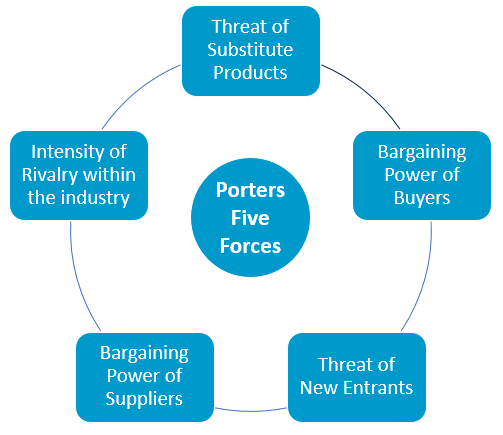Difficulty: Time:
What is Porters Five Forces?
Porter’s Five Forces is a simple tool to understand the situation a company is in, or will be going into. This is a great tool to effectively visualize the strengths and weaknesses of the company’s current competitive position, or the position you may be moving into. It was created some decades ago by Michael Porter at the Harvard Business School as a tool to analyze the potential and profitability of an industry.
What is Porters Five Forces model used for?
Business strategists use Porter’s Five Forces as a simple framework to analyze the competition in an industry prior to beginning their business strategy development. The Five Forces consist of: Threat of Substitute Products, Bargaining Power of Buyers, Threat of New Entrants, Bargaining Power of Suppliers and the Competitive Rivalry. From these five forces you could get a sense of the attractiveness of the industry, if the competitive intensity is high then it may be less profitable to enter or continue with the current business strategy and vise versa. Thus, you could say that an industry is not attractive because the combination of all the threats will in hinder profitability.
In the overall hierarchy of a business strategy, Porters Five Forces should be done after you have already looked at the macro-environment. As this model dives deeper and closer to the heart of the industry. Though Michael Porter created this too in response to the popular SWOT analysis, we greatly believe that the two can still coexist together and actually strengthen your business strategy development.
How do you use it in practice?
Lets dive straight in. The Five Forces tool can determine the competitive environment in an industry, and in this section we will analyze each one of them. Keep in mind while you go through here, that is could be an organized brainstorming exercise. But, before you move on list them depending on importance or power. This will make it much easier to re-use and think about when you move to other tools in which we will reference this Five Forces tool.
Bargaining Power of Suppliers: Suppliers come in many shapes and sizes. They may supply you with raw materials, specific components, or even expertise services. If there are a limited amount of suppliers who can supply you with the resources you need, you have a problem. They will be able to charge excessively high prices and you won’t have much of a choice but to pay it. Other things to consider:
- If the supplier number is more concentrated than the industry it sells to
- If the suppliers products is unique and you, as the buyer, would have costs for switching. The supplier doesn’t have to worry about the other products for sale in the industry because it is the only one supplying this specialized product
- If the supplier could pose a threat of integrating into the business. This could be pose as a threat against trying to improve the conditions of the purchase
- If your industry is a small piece of his pie. In other words, he is making most of his revenue from different industries
- Another thing to look at could be how labor unions may affect your business. Whether you employ those within a union, or your suppliers have unionized employees.
The higher the bargaining power of suppliers, the higher your costs will be to produce your product and run your business.
Bargaining Power of Buyers: Here you need to ask yourself how easily can your customer negotiate down the prices. Its basically the same as the Bargaining power of suppliers, except from a different angle.
- Are your customers concentrated or do they purchase in large quantities? The greater volume they purchase the greater the likelihood they will negotiate prices down.
- Is your product fairly standard compared to the industry. In this case, buyers could quite easily shift to alternative sources.
- Are the products you provide some sort of components to a final product? This would cause your buyers to shop around for more favorable prices, in order to drive their costs down.
- Also, if the industry you are selling to is earning low profit margins, the buyers will be quite price sensitive.
- Can your product save money of either the industry you are selling to or the end user, which will increase your buyers value proposition.
- Lastly, if your buyers have the possibility to integrate backwards and produce this product themselves, you cannot but lower prices so they stay your customers and not your competition.
- Is your product important, where the quality needs to be high. Or is it a product/component that is unimportant. In other words, if your product malfunctions could it lead to large significant losses. If so, your buyers may be less likely to have the power to lower the price because they want the highest quality.
The higher the bargaining power of your buyers, the lower your revenue will be.
Threat of New Entrants: According to Porter there are six major sources of entry, which we will look at here.
Economies of scale: This challenges companies who wish to enter your industry to either come in on a large scale or be forced to accept disadvantages relating to costs.
Product Differentiation: How loyal are your customers, would they stay with you if a new competitors comes around? Here you focus on the brand, either yours or those in the industry. Would a new entrant need to spend a lot of money in order to generate brand awareness?
Cost disadvantages independent of size: Here we look at expertise in the industry. How costly is the learning curve? Such as gaining special business partnerships, or access to the best sources of raw materials at competitive prices.
Capital Requirements: Is the industry a capital heavy industry? Would new entrants need to raise or invest large amounts of capital to produce the product.
Access to distribution network: Any new company will need to find a way to distribute their products or services. How accessible are the distribution networks, are their limited channels? Can someone create their own distribution network?
Government policy: Finally, the biggest challenge if applicable is government policy. Has the government put up certain limits in your industry which would make it either difficult of impossible for others to compete
Threat of Substitution: Here you should look closely at the products you are selling. Are they unique? Can they be replicated quite easily? In an industry where substitute products can be replicated easily, it will be hard to have high profit margins. Whether it is an existing industry or a new industry you are entering or creating.
On the other hand, in profitable markets where high returns are possible new entrants will come knocking on your doors. This will result in higher competition with a greater supply of choices to the market and will eventually lead to decreasing profitability for the whole industry through price reductions.
Competitive Rivalry: Here what is most important is the competitors themselves. What are their capabilities, are their products or services as attractive as yours or better? On the other hand if no one else in the industry is able to provide what you provide, you could consider yourself having strength in this category. Some other things to consider for this element are:
- What are the levels of advertising expenses between you and the rest of your competition?
- Do you have a competitive advantage which can be sustainable through innovation? Can this innovative approach be duplicated?
- Is industry growth slow? How concentrated is the industry? Many firms may be competing for a non-expanding piece of cake.
- Don’t forget in many industries today, your competition may be coming from outside of national borders. The internet decreases the size of the world, through real-time communication and low shipping costs.
- What differentiates your products, services and value proposition from those of competitors? Is there a difference, who is better?
Tips and Tricks (What to do and don’t do)
As mentioned before, use this tool to have an organized brainstorming exercise with your team. This will provide you with an understanding towards which strategy you should lean towards. From Porters perspective once the Five Forces are completed you could jump into his, Porter’s Generic Strategies model in order to generate a strategic option for your business. Though, we also believe that other strategic options can be generated in a different way as well. We will discuss this in a different article.
It may seem difficult sometimes to get all the information because in some cases that information may not be available to you about certain parts of the world. In that case, its okay to make assumptions. Share those assumptions with others, with your team or with people in your network that may be able to shine a light on those areas.
Example at a real use case
Lorem ipsum dolor sit amet, consetetur sadipscing elitr, sed diam nonumy eirmod tempor invidunt ut labore et dolore magna aliquyam erat, sed diam voluptua. At vero eos et accusam et justo duo dolores et ea rebum. Stet clita kasd gubergren, no sea takimata sanctus est Lorem ipsum dolor sit amet. Lorem ipsum dolor sit amet, consetetur sadipscing elitr, sed diam nonumy eirmod tempor invidunt ut labore et dolore magna aliquyam erat, sed diam voluptua. At vero eos et accusam et justo duo dolores et ea rebum. Stet clita kasd gubergren, no sea takimata sanctus est Lorem ipsum dolor sit amet.







